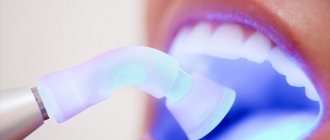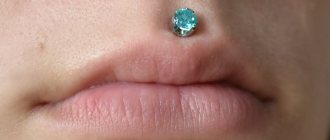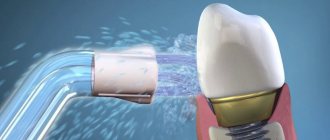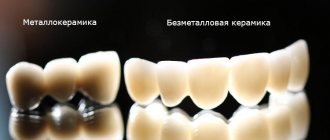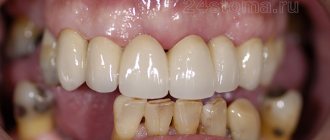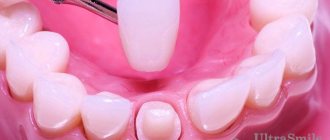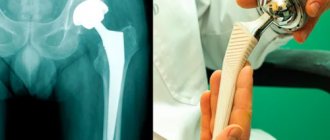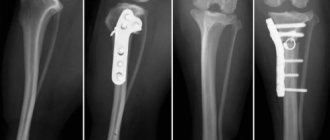From this article you will learn:
- pros and cons of ceramic zirconium crowns,
- their varieties - “Multi-layer”, monolithic, etc.,
- how much does a zirconium crown cost for 2022.
Zirconium crowns are a variant of dental crowns for restoring damaged and missing teeth, the material of which is zirconium dioxide (ZrO2). This material belongs to metal-free ceramics. Unlike metal-ceramics, zirconium dioxide crowns do not have a metal frame inside, which makes it possible to achieve a higher level of aesthetics in dental prosthetics (compared to metal-ceramic crowns).
Zirconium crowns also have very high strength. They are considered to be at least 2-4 times stronger than crowns made from other types of metal-free ceramics (for example, porcelain crowns). But all this is true only for crowns that are made of monolithic zirconium dioxide. In most cases, only the internal frame is milled from zirconium dioxide, on top of which layers of porcelain mass are applied. This allows you to achieve a higher level of aesthetics, but on the other hand, it increases the risk of chipping.
Zirconium crowns: photo
However, in recent years, a new technology for manufacturing zirconium crowns has emerged, which is called “Multi-layer”. This technology makes it possible to produce crowns from monolithic zirconia (i.e., without applying a surface layer of porcelain), and at the same time obtain esthetics almost comparable to the most esthetic types of metal-free ceramics, for example, crowns made of feldspathic porcelain or IPS E-max ceramics.
All this became possible thanks to the emergence of modern versions of zirconium dioxide blocks (disks), which are made using the “multi-layer” technology and also have high transparency (translucency characteristic of natural tooth enamel). In this article we will talk not only about the pros, but also about the disadvantages of ceramic crowns made of zirconium dioxide, and also why reviews of zirconium dental crowns from real patients are very often negative. And you probably already realized that this happens when dental clinics save money on better-quality consumables.
Zirconium crowns – their types, manufacturing methods
The production of zirconium crowns occurs using CAD/CAM technology, requiring very expensive equipment. This technology means that crowns are made by milling zirconium dioxide blocks on a computer-controlled machine. To make a crown, the dentist must first take an impression of the teeth (using a traditional impression or an intraoral scanner). Next, using this impression, your future crown is modeled on a computer, and its digital profile is transferred to a milling machine, which grinds the crown.
Milling zirconium crowns (animation + video) –
Milling of crowns occurs without human intervention at all. We have already said above that the quality (aesthetics) of zirconium crowns largely depends on the quality of the zirconium dioxide blocks from which your crowns will be milled. But another subtle point is building a computer model of your future crowns. This can be done in 2 ways - 1) computer models of crowns can simply be taken from the gallery that is stored in the program, 2) your crowns can be drawn manually by a dental technician.
Of course, the second option (if the technician’s hands grow from the right place) will allow for maximum aesthetics, i.e. do not stand out against the background of your own teeth. But this requires a highly qualified dental technician, time investment and, accordingly, increases the cost of crowns. Therefore, the price of zirconium crowns in different Moscow clinics can vary greatly. A zirconium crown with good aesthetics will cost an average of 30,000 to 40,000 rubles for 1 crown, but for crowns costing 20,000 rubles initially, you shouldn’t expect too much.
There are 2 types of zirconium crowns:
- Classic zirconium crowns (Fig. 4) –
Such crowns consist of two layers. Inside, they have a frame milled from zirconium dioxide, which is then lined with layers of porcelain. The zirconium frame makes the crown durable, and the porcelain mass on its surface allows the crown to have good aesthetics.
- Monolithic zirconium crowns (Fig. 5) –
they consist of solid zirconia and do not have a porcelain layer on the surface.
Just a few years ago, such crowns were made mainly only in the area of the chewing teeth, which was due to their more modest aesthetics. However, at the moment, many manufacturers have begun to produce zirconium dioxide blocks made using the “Multi-layer” technology. Zirconium dioxide blocks made using this technology have a gradient of color and transparency. As a result, zirconium crowns milled from such blocks will also have a gradient of color and transparency, which is inherent in real living teeth. But “Multi-layer” zirconium blocks have a higher cost, and therefore most dental clinics use much cheaper zirconium dioxide blocks (opaque, white), which does not allow zirconium crowns to have really good aesthetics.
Please note that real teeth have a gradient of color and translucency. In the neck area, the teeth always have the least transparency and a darker color, and the closer to the incisal edge of the front teeth or the cusps of the chewing teeth, the whiter and more transparent the enamel becomes. Zirconium dioxide blocks using “Multi-layer” technology have a smooth transition of color and transparency, which makes it possible to give monolithic zirconium dioxide crowns ideal aesthetics.
CAD/CAM production of zirconium crowns –
After the teeth are ground down for crowns, a three-dimensional model of the patient’s teeth is created on a computer using a special intraoral digital scanner (Fig. 6). Based on this model, the doctor uses a special computer program to calculate the size and shape of future crowns and creates a three-dimensional model of them (Fig. 7). It is at this stage that the doctor can plan the production of either a monolithic zirconium crown, or the production of only a zirconium crown frame, which will subsequently be lined with porcelain.
Next, the three-dimensional model of the crowns or their zirconium frame is transferred to a computer-controlled milling machine, where the actual process of milling zirconium dioxide blocks occurs (Fig. 8). After milling is completed, the finished structure is fired in a special furnace at high temperature - due to which the zirconium dioxide acquires the strength of the metal. If we are talking about the manufacture of traditional zirconium crowns, then layers of porcelain mass are then applied to the hardened zirconium frame (Fig. 9-11) - after which they are baked again in an oven at high temperature (24stoma.ru).
CAD/CAM technology for manufacturing zirconium crowns –
Zirconium frame and porcelain lining –
The weak point of such zirconium crowns (with porcelain veneer) is the connection boundary between the zirconium frame and the porcelain layer. The strength of the zirconium frame itself is very high and amounts to more than 900 MPa, while the strength of the porcelain coating is only about 80-100 MPa. In addition, the use of dyes in the process of applying layers of porcelain mass, as well as the gradual “aging” of crowns, lead to a subsequent deterioration in the bond between zirconium and porcelain, which increases the risk of chipping the porcelain veneer.
HOW DO WE INSTALL CROWNS?
- The beginning is a mandatory diagnosis on a computed tomograph. Only in our clinic, Diagnocat artificial intelligence is used for CBCT analysis! The program uses 3D images to determine the condition of the teeth, helps the doctor make an accurate diagnosis and plan treatment.
- Treatment planning by an orthopedic dentist, selection of the type of crowns.
- Therapeutic treatment (if there is untreated caries or pulpitis). All teeth must be treated before prosthetics.
- The dentist prepares (grinds) the tooth to the thickness of the future “cap” and takes impressions of the jaws. While future ceramic crowns are being manufactured, temporary crowns are installed.
- The shape of the crown is modeled using special computer programs, and the color is carefully selected to match the color of the enamel of your teeth. Next is fitting. And finally - fixation!
Monolithic zirconium crowns (Multi-layer) –
While for traditional zirconium crowns only the frame is milled from zirconium dioxide, monolithic zirconium crowns are made entirely of zirconium. Therefore, immediately after milling, they will already have a finished shape, and layers of porcelain will no longer be applied to their surface. Typically, the weak point of monolithic zirconia crowns is aesthetics, because... Not all clinics are ready to make zirconium crowns from expensive zirconium dioxide blocks (with “Multi-layer” technology and high transparency).
Standard zirconia blocks have a bright milky color and lack transparency, and therefore monolithic crowns made from such materials will not resemble real teeth. Their only advantage is their low price, which dramatically reduces the cost of zirconium crowns and increases the profit of a dental clinic. Monolithic zirconium crowns should be made only from high-quality zirconium dioxide produced using the “Multi-layer” technology - for example:
- Katana® UTML (Japan),
- Katana® STML (Japan),
- Prettau® Anterior from (Germany),
- Upcera® STML (China).
For example, the cost of just one of the above zirconium dioxide disks is from 17,000 rubles, and the Prettau Anterior or Upcera STML disks are from 10,000 rubles. At the same time, the price for zirconium dioxide discs without “Multi-layer” technology (i.e. without a gradient of color and transparency) starts from only 3000-4000 rubles, which certainly reduces the cost of manufacturing zirconium crowns in a dental laboratory.
Therefore, when consulting with a dentist, you should always ask for details - which manufacturer of zirconium dioxide blocks their dental laboratory works with. Will the computer modeling of the crowns be done by a dental technician, or will the crown options be taken simply from a ready-made “library”. Otherwise, it can be excruciatingly painful later – when you see that the zirconium crowns you just made are significantly different from your own neighboring teeth.
Clinical case No. 1 (multi-layer) –
In these photos you can see the aesthetics of a bridge and single crowns made of zirconium dioxide, made using the “Multi-layer” technology (they have just been manufactured and are still being fixed on a plaster model of the patient’s teeth). The bridge prosthesis in the projection of 14-15-16 teeth is made with pink artificial gum, and the remaining units are made in the form of single zirconium crowns. Pay attention to the natural color and transparency that change - in the direction from the necks of the crowns to the cutting edge.
Indications and contraindications for installation
Zirconium dioxide crowns have indications and contraindications for installation. Indications:
- persistent discoloration of tooth enamel;
- destruction of the natural dental unit as a result of caries, trauma, chipped enamel;
- congenital dental anomalies – shape, height, enamel;
- large interdental spaces (trema), including between the front teeth (diastema);
- installation of a prosthesis on an implant;
- intolerance to other dental materials.
Contraindications for installing zirconium dental crowns:
- severe malocclusion – deep bite;
- bruxism (involuntary grinding of teeth) – the risk of rapid wear of antagonist teeth in the opposite dentition;
- very small teeth;
- increased abrasion of hard dental tissues;
- infectious and inflammatory processes in the oral cavity - prosthetics are allowed only after complete treatment;
- diseases that contribute to a persistent decrease in immunity - diabetes, AIDS, oncological processes;
- severe general illnesses and psychoses;
- pregnancy.
Zirconium crowns: before and after photos
Below we have given successful examples of prosthetics for front teeth with zirconium crowns. However, to be objective, not all patients will achieve such an aesthetic result (as in Fig. 12-19). Below in the article we will also show unsuccessful examples of zirconium crowns on the front teeth.
Clinical case No. 2 –
Clinical case No. 3 –
Clinical case No. 4 –
Is it possible to save money on installing zirconia crowns in the smile area?
Theoretically it is possible, but is it worth it? Different dental laboratories use different zirconium blocks from which crowns are made. You can save your budget by choosing a traditional material in which the zirconium blocks have a milky tint. However, in this case the aesthetics will not be ideal.
If you want a truly beautiful smile zone, to smile freely and widely, experts do not recommend skimping on installation. You can choose a product made from translucent zirconium blocks that have higher levels of transparency and shades.
Recently, dentists have been using so-called hybrid crowns - a combination of zirconium dioxide and glass ceramics. This option is considered the most expensive, but in terms of its reliability, performance characteristics and aesthetics it is at its best!
Zirconium dioxide crowns: expert reviews
On the websites of dental clinics and during consultations, you will probably come across the fact that zirconium crowns will be strongly recommended to you. Over the years of using these crowns in practice, we have developed a list of optimal clinical situations in which these crowns would actually be a good choice.
Optimal indications for zirconium crowns –
- bridges on chewing teeth,
- bridges on the front teeth (provided that you need a bridge that will consist of at least 4 units),
- single crowns and bridges on implants,
- in the presence of bruxism.
When zirconium crowns may not be the best choice –
- single crowns for front teeth,
- 3-unit bridges on the front teeth.
In these cases, it is better to prefer glass-ceramic crowns IPS E-max (based on lithium disilicate) to zirconium, provided there is no bruxism. Ceramic crowns made from the “E-max” material allow you to achieve truly ideal aesthetics, which in some clinical situations cannot be achieved even with zirconium crowns using the “Multi-layer” technology. But crowns made of E-max ceramics have a limitation - the length of bridges made of this material can be no more than 3 units inclusive.
It is better to choose E-max ceramics for those patients who have a high degree of transparency of the enamel of their front teeth, as well as for patients with high aesthetic needs. This can be explained very simply: ceramics based on porcelain or lithium disilicate have a more pronounced coefficient of transparency - the most consistent with the transparency of natural tooth enamel. In addition, working with these types of ceramics provides more color solutions than a dental technician has when working with zirconium dioxide.
Features of care
Zirconium dentures do not require special care. The set of procedures does not differ from standard daily care for natural teeth:
- regular brushing with toothpaste without solid particles (containing abrasives);
- preference should be given to brushes designed for cleaning dentures;
- rinsing the mouth after eating;
- use of special superfloss threads.
The high strength of zirconium products allows you to consume products without any restrictions. Apples, carrots, hard chocolate and similar foods can be safely bitten with new teeth. However, you should not chop nuts, ice, or candy with the help of dentures.
A prerequisite for care is to visit the dentist at least once a year. Following the recommendations extends the life of artificial teeth, eliminating side effects such as cracks and chips.
Zirconium dioxide crowns: pros and cons
Despite the fact that most often dental clinics try to hush up and not focus patients’ attention on the disadvantages of zirconium crowns (which we will also introduce you to below) - they still have very tangible advantages. Dentists' reviews of zirconium crowns will often be positive only due to their following characteristics:
- Incredible strength - after firing in a furnace at high temperatures, zirconium dioxide acquires the strength of metal, making it possible to make bridges of any length from it. However, unfortunately, zirconium dioxide is superior to other types of metal-free ceramics only in this area, while being inferior to them in aesthetics. Plus there is a problem with chipping (see below).
- Teeth need to be ground less - grinding of the tooth for a crown is required here in a smaller volume (compared to metal-ceramics), because A zirconium crown is much thinner than a metal-ceramic crown. This means that more of the natural tooth structure is preserved and thus the reliability and service life of the crowns increases.
- Biocompatibility - these crowns behave well in patients with allergies to metals, and they are not characterized by the phenomenon of galvanism (the formation of microcurrents in the presence of crowns made of dissimilar metals in the mouth). The latter is very important in smokers and patients with various diseases of the oral mucosa.
- Lack of hypersensitivity - metal-ceramic crowns on living teeth are characterized by the problem of increased sensitivity to cold and hot, which is associated with the presence of a metal frame that transfers heat and cold well. In turn, the zirconium frame well resists the transfer of thermal and cold irritants into the tooth and, thus, reduces the risk of developing hypersensitivity.
- The best option for crowns on implants - zirconium crowns are almost perfect in only one way - when using prosthetics with crowns on implants.
Under these crowns, abutments are used, also made of zirconium dioxide, and therefore there is good adaptation of the gums (unlike the situation when metal-ceramic crowns and titanium abutments are used). Good adaptation of the gums to the surface of the zirconium abutment allows for good aesthetics of the gums around the implant. The latter is very important, because in 90% of cases, patients remain dissatisfied with the quality of implantation precisely because of the poor aesthetics of the gums around the implant, and not at all because of the threat of rejection or other problems.
Manufacturing and installation features
The first stage of prosthetics is the sanction of the oral cavity, including the treatment of inflammatory and carious processes. During the preparation process, the dental nerve is removed and the enamel is ground down.
The next step will be scanning the teeth and creating an image (in three dimensions) of the artificial crowns via a computer. Using special programs, a kind of sketch is created, which is placed in equipment that creates a frame part from the image.
The finished crown is fired in an oven and covered with porcelain or other material. Next, the product is painted in the desired shade and fired again.
Today, modern technology is used, which is considered universal, CAD/CAM. It meets all the requirements for the production of crowns for dental prosthetics.
Key disadvantages of zirconium crowns –
Despite the above advantages, zirconium crowns also have equally important disadvantages. But all these disadvantages are typical only for crowns made from cheap blocks (or disks) of zirconium dioxide that do not have a gradient of color and transparency.
1) Not suitable for front teeth –
Most dentists will praise the aesthetics of this type of crown, but in reality there are many complaints from patients about them. Crowns and veneers made of zirconium dioxide (without “Multi-layer” technology, as well as a high degree of transparency, i.e. transparency) are not suitable for front teeth due to the opacity of the zirconium frame. The aesthetics of zirconium crowns is also negatively affected by the significantly smaller choice of color shades, for example, in comparison with crowns made of E-max pressed ceramics.
All this increases the risk that artificial crowns and veneers will not blend in with neighboring teeth in color and transparency. Be prepared for the fact that if you decide to get zirconium crowns on your front teeth, they may not look very natural. Pay attention to the lack of transparency and the unnatural milky color of the crowns - in Fig. 20-22.
Unsuccessful prosthetics with zirconium crowns:
In recent years, some manufacturers have begun producing zirconium dioxide blocks with increased transparency. Translucent zirconia with a color gradient - allows you to achieve higher aesthetic results than opaque bright white zirconia. But nevertheless, in any case, we do not recommend making zirconium crowns and veneers in patients with increased aesthetic requirements, as well as in patients with highly transparent tooth enamel.
The use of opaque blocks of bright white zirconium dioxide leads to the fact that the finished crowns will have an unnatural milky color. Therefore, if you want perfect aesthetics, it is better to give preference to IPS Emax. If you are still set on zirconium crowns, then you will have to sweat a little, finding out the manufacturer of zirconium dioxide blocks in each clinic (we have given the rating of manufacturers at the end of the article).
Trying on finished zirconium crowns – video 3-4
Video 3 clearly shows that the crowns on the four front upper teeth are milky in color and do not at all match the color of the patient’s own teeth. It must be stated that if you want to make yourself zirconium crowns, in 50% of all cases they will look exactly like this - artificial and unnatural. In video 4 , the crowns have a more natural color and shape, but, unfortunately, the patient will most likely be left with black triangles in the interdental spaces (since in this case the gingival papillae are unlikely to be able to fill the interdental spaces in the future).
2) Chips of ceramics –
The problem of chipping is typical for zirconium crowns lined with a layer of porcelain on the outside.
Despite the very high strength of the zirconium frame itself, about 900 MPa (megapascals), the strength of the connection between the porcelain layer and the zirconium frame is only about 100 MPa. This is where zirconium crowns are vulnerable, which may not be as strong as they are advertised. Thus, the cause of chipping is a rather weak connection between the zirconium frame and the surface layer of porcelain. This is why many dentists do not recommend making porcelain-veneered zirconium crowns, especially in the posterior teeth area. According to statistics, chips of the surface layer of porcelain of zirconium crowns are observed in at least 6% of patients after 3 years, and in at least 10% of patients after 5 years of use.
For example, when using metal-ceramic crowns over 10 years of observation, chips occur in only 10% of patients (which is 2 times less likely than with zirconium crowns). And chipping occurs even less often when using IPS E-max pressed porcelain ceramic crowns. A way out of this situation may be to manufacture monolithic zirconium crowns on the chewing teeth that do not have a surface layer of porcelain. But at the same time, the absence of porcelain will naturally worsen the aesthetics.
3) Abrasion of antagonist teeth –
Zirconium dioxide is a very durable material that is not subject to abrasion. Therefore, friction against the zirconium crowns of antagonist teeth can, in some cases, lead to an acceleration of the physiological wear of these teeth. Therefore, if a patient has increased tooth wear, zirconium crowns are usually placed immediately on the antagonist teeth.
4) Lack of color solutions –
When you order ceramic crowns made from feldspathic porcelain or IPS E-max pressed porcelain, the dental technician has many options to create crowns that are the perfect shade. As a result, artificial crowns made from these types of ceramics can be virtually indistinguishable from your own teeth. But when working with zirconium dioxide, the dental technician will have a much more limited arsenal of shades that can be given to artificial crowns.
Life time
The service life of the product may be reduced for several reasons:
- loosening of the tooth due to developing periodontal disease or periodontitis, less often due to the absence of an adjacent tooth or bruxism;
- violation of the tightness of a two-layer crown due to the use of low-quality materials or careless handling on the part of the patient;
- tooth decay due to reasons: hormonal imbalances, metabolic disorders, poor dental care, lack of calcium.
- chipping or breaking of the crown as a result of injury, biting hard food, malocclusion or bruxism.
Zirconium crowns: price in Moscow and regions
For zirconium crowns, the price below is indicated for 2022. The price already includes all expenses - with the exception of the cost of possibly necessary therapeutic preparation of the tooth for prosthetics, as well as the cost of a temporary plastic crown (1 temporary crown - from 2000 rubles).
- 1 zirconium crown per tooth – price not less than 30,000 rubles.
- 1 zirconium crown on an implant – from 30,000 to 40,000 rubles.
Important: unfortunately, these are the prices you should expect for zirconium crowns with good aesthetics. In this case, much more expensive zirconia blocks with a gradient of color and transparency (multi-layer) will be used, and you should also expect that the computer models of yours will be drawn by hand, and not taken from a “library of ready-made images”. But you can easily find clinics that offer the cost of a zirconium crown from 15,000 or 20,000 rubles.
Of course, in this case much cheaper zirconium dioxide blocks will be used - bright white in color, without a gradient of color and transparency. And even with superficial application of layers of porcelain (in order to improve aesthetics), you will receive crowns of a milky, unnatural shade that will stand out against the background of your own teeth. An option to save money and at the same time get decent aesthetics is another option for prosthetics (especially pressed ceramics “E-max”).
Alternative prosthetic options - the price of ceramic crowns made of lithium disilicate IPS E-max, also made using CAD/CAM equipment - will also average about 30,000 rubles. The cost of crowns made from IPS E-max PRESS, made by pressing, will average from 20,000 to 24,000 rubles.
→ Cost of metal ceramics
In what cases do patients choose zirconium crowns, and when should they be abandoned?
Zirconium crowns are installed if your teeth are in unsatisfactory condition and cannot be saved with ordinary fillings and restoration. However, the main reason for their installation is the absence of natural teeth.
Zirconium prostheses are used for almost all types of prosthetics:
- single teeth;
- groups of missing units (a bridge is made from zirconium dioxide material);
- one or more teeth that are restored with implants.
It is worth abandoning zirconium dioxide if the patient is faced with the task of increasing savings on prosthetics. For example, to restore chewing teeth, install metal-ceramics, and restore the smile area with crowns made of zirconium dioxide material.
If a patient has bruxism, zirconia prostheses are also not recommended. For such people there are other alternative restoration paths.
When a patient is missing one tooth in the smile area, specialists are not always in favor of installing zirconium dioxide. Sometimes it is more rational to install a crown made of porcelain or glass ceramics, which can also be selected exactly in shade and transparency. It all depends on the initial condition of the oral cavity, the allocated budget for dentures and the individual preferences of the patient.
Important – zirconium dioxide manufacturer
In different dental clinics, zirconium dioxide blocks of completely different quality and aesthetic properties are used to make zirconium crowns. These blocks/discs are produced by different manufacturers, and the clinic here can save a lot on the cost of the material. The fact is that standard zirconium dioxide disks/blocks for milling are almost completely opaque and white.
As we said above, the price of such discs starts from 3,000 rubles, which is much cheaper than zirconium dioxide discs with Multi-layer technology, the price of which usually ranges from 10,000 to 17,000 rubles per disc. The “multi-layer” technology implies that the discs will consist of pre-colored zirconium with a smooth color change from the cervical area to the cutting edge, and in addition, due to the addition of yttrium to zirconium, a high level of transparency (transparency) of the material can be achieved.
Below we present a rating of zirconium dioxide discs, which was obtained based on a comparison of the characteristics of discs from different manufacturers, as well as reviews from dentists (link to an English-language study) -
- “Katana UTML” (Japan) is the best material that allows you to make zirconium crowns, which are only slightly inferior in aesthetics to ceramic crowns from “IPS Emax”.
- In 2nd place are the materials “Katana STML” (Japan) and “Prettau Anterior” (Germany), etc.
Recently, more and more new manufacturers of zirconium dioxide blocks with “Multi-layer” technology have been appearing, and it is quite difficult to keep track of them. For example, there is a more budget-friendly (compared to Katana or Prettau) zirconium dioxide Upcera® STML, which is produced by a leading Chinese manufacturer of dental materials and is of fairly high quality.
Hybrid zirconium crowns –
Dental materials are being improved all the time, and manufacturers are trying to combine the positive properties of different materials in one. For example, combining the strength of zirconium dioxide and the aesthetics of lithium disilicate. This is how the group of materials “lithium silicates reinforced with zirconium dioxide” appeared. An example of such materials is
- "Celtra Duo" - manufacturer Dentsply (USA),
- “Suprinity” – (Germany).
Important: therefore, before agreeing to prosthetics with zirconium crowns, you should at least find out about the manufacturer of zirconium dioxide discs that is used by this dental clinic. If we are talking about front teeth, then you need to find out - 1) whether it is a “multi-layer” or NOT a “multi-layer”, 2) whether their zirconium dioxide has a sufficient degree of transparency (transparency), 3) we are talking about monolithic zirconium crowns , or about crowns with the application of a surface layer of porcelain, 4) modeling of crowns on a computer is carried out by a dental technician or “images” are taken from a file library. We hope that our article: Zirconium dental crowns reviews, price – was useful to you!
Sources:
1. Personal experience as a dentist, 2. “Orthopedic dentistry. Textbook" (Trezubov V.N.), 3. National Library of Medicine (USA), 4. "Zirconium crowns" (Gevorgyan Kh.M., Zhidkikh E.D.), 5. https://www.realself. com/,6. https://www.bauersmiles.com/.
What is zirconium
Zirconium is the element zirconium (Zr). The periodic table indicates its atomic weight 91.22 and number 40. It is included in food products, stones, and ores.
The compound of zirconium with oxygen is a silver-gray metal. Reminiscent of stainless steel, white gold. Before purification, it often contains radioactive impurities. After removal it must comply with GOST 21907-76. It is opaque, malleable, viscous, resistant to corrosion, is not magnetized, but is attracted by a strong field.
Zirconium in jewelry is used in the form of metal inserts and frames, for the manufacture of earrings.
It is also used for the synthesis of cubic zirconia. These are transparent stones with brilliant clarity and radiance. Dark grey, graphite or black artificial gems are called black zirconium.
Cubic zirconias also come in:
- yellow;
- orange;
- blue;
- red;
- blue;
- green;
- pink;
- purple;
- golden with a brown tint.
Zircon differs from metal in that it is a natural gemstone of the silicate group. It contains the element Zr, which is why the mineral is used to extract zirconium. The color ranges from colorless (Matar Diamond), golden (Siamese), blue (Starlite) and brown (Malacon).
In addition, watch the video review to continue the description of the metal:
Read more about the differences between zircon, zirconium and cubic zirconia in the article.
